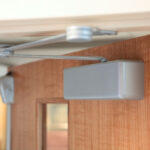 In the early 1990’s, the codes and standards related to accessibility would typically describe where accessible door openings were required, and/or identify an accessible route through a building. This philosophy has changed, and today’s building codes require doors and hardware to be accessible unless they are specifically exempt from the accessibility requirements.
In the early 1990’s, the codes and standards related to accessibility would typically describe where accessible door openings were required, and/or identify an accessible route through a building. This philosophy has changed, and today’s building codes require doors and hardware to be accessible unless they are specifically exempt from the accessibility requirements.
The requirements related to door openings are too complex to address in one post, but here are a few of the most frequently asked questions, with links to additional information:
What is the maximum force allowed for opening a swinging door?
The answer to this question depends on the type of door – interior or exterior, fire-rated or non-rated. For interior, non-fire-rated swinging doors, the model codes and accessibility standards allow a maximum opening force of 5 pounds. Exterior doors and fire doors are not addressed in the opening force section of the accessibility standards, and the allowable force to open these doors is typically limited by the building code or fire code. For example, the International Building Code (IBC) and International Fire Code (IFC) allow exterior doors and fire doors to be manually opened with up to 30 pounds of force to set the door in motion, and 15 pounds of force, maximum, to open the door to the fully-open position.
What is the maximum allowable force for operating door hardware?
The ADA and ICC A117.1 requirements are fairly consistent with regard to door openings, but there is an important difference when it comes to the limits on operable force. The most recent edition of the ADA standards, published in 2010, limits the force to operate door hardware to a maximum of 5 pounds. The ICC A117.1 standard was modified in the 2017 edition to include prescriptive requirements for the force to operate door hardware, and the limits differ from the 5-pound force stated in the ADA standards. For hardware operated with a forward, pushing or pulling motion (ex. panic hardware), ICC A117.1 states that the hardware must operate with 15 pounds of force or less. For hardware operated with a rotational motion (ex. lever handles), the standard limits the operable force to 28 inch-pounds. The forces included in ICC A117.1 have also been incorporated into the 2021 edition of the IBC.
Do the accessibility standards address keys and electronic credentials?
The accessibility standards include requirements related to “operable parts” of door hardware such as thumbturns, keypads, turn-buttons, and of course, lever handles. In addition to the limit mentioned above on the operable force, the standards mandate operable parts that do not require tight grasping, pinching, or twisting of the wrist. Keys and electronic credentials used to operate locks are not covered by the standards, because they are not considered operable parts. The standards do not prohibit the use of keys and credentials that require physical dexterity, however, accommodations may need to be made for employees or residents who are unable to operate hardware using these methods.
Are automatic operators required by the codes and standards?
Prior to 2021, the codes and standards did not mandate automatic operators, although these products are sometimes installed to overcome an accessibility issue such as limited maneuvering clearance, or opening force that exceeds the maximum allowed by code. A change was made to the 2021 edition of the International Building Code (IBC), mandating automatic operators on accessible public entrances in buildings of certain occupancy types and occupant loads. This Decoded article addresses the code change in depth.
Where can I learn more about the accessibility requirements for doors?
There are two accessibility standards that are used in most U.S. states – the ADA Standards for Accessible Design, and ICC A117.1 – Accessible and Usable Buildings and Facilities. The U.S. Access Board has published a helpful online guide to the ADA standards, and there is a link to the guide in this post. ICC A117.1 is available for purchase on the website of the International Code Council, and there is also a Commentary version available which includes additional information about the intent of the requirements. The Accessibility page of iDigHardware (available on the Topics menu) covers some of the important requirements of the accessibility standards related to doors and hardware. For specific requirements, refer to the adopted codes and standards in the project’s jurisdiction.
I hope this answers any questions you may have…if not, leave your question in the comment box.
For answers to more frequently asked questions, check out these recent FAQ posts:
- FAQs About Sliding Doors
- FAQs About Flush Bottom Rail Requirements
- FAQs About Fail Safe and Fail Secure Hardware
- FAQs About Roof Doors
- FAQs About Smoke Barrier Doors in Health Care Facilities
- FAQs About Electromagnetic Locks
- FAQs About Low-Energy Automatic Operators
- FAQs About Health Care Corridor Doors
- FAQs About Controlled Egress Locks in Health Care Facilities
You need to login or register to bookmark/favorite this content.










Leave A Comment